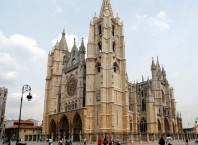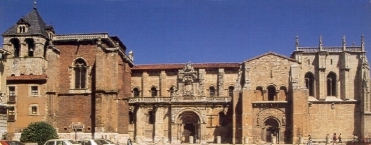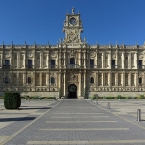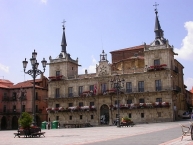Cycle Tour León - Gijón
Planned tour
Actions
![]()
Please wait - map data are loading
Added on 07 Nov 2019,
on 07 Nov 2019
Actions
Cycle route metrics
planned
ridden
Total distance in km
186
0
Cumulative elevation gain in m
3.358
0
Avg. slope uphill in %
1,81
-
Cumulative elevation loss in m
4.196
0
Information about rights to the gps-track data | |
|---|---|
Rights owner | |
Rights characteristic / license | cc0: Public Domain no Rights reserved |
Link to the description of the license | |
GPX file uploaded | by biroto-Redaktion on 07 Nov 2019
|
Track points in total
3.288
0
Track points per km (avg)
18
0
Start/endpoint
Start location
León, Castile and León, ES (844 m NHN)
End location
Gijón/Xixón, Asturias, ES (6 m NHN)
Beds4Cyclists, worth visiting and infrastructure
Name and address
Latitude / Longitude
Phone
Fax
Mobile
Type of accommodation
Rating for cyclists
Route km
Dist. to route
Elevation
0 km
0,5 km
837 m




León (/leɪˈɒn, -ˈoʊn/; Spanish: León [leˈon]; Leonese: Llión [ʎiˈoŋ]) is the capital of the province of León, located in the northwest of Spain. Its city population of 131,680 (2012) makes it the largest municipality in the province, accounting for more than one quarter of the province's population.
Founded as the Roman military encampment of the Legio VI Victrix around 29 BC, its standing as an encampment city was consolidated with the definitive settlement of the Legio VII Gemina from 74 AD. Following its partial depopulation due to the Umayyad conquest of the peninsula, León was revived by its incorporation into the Kingdom of Asturias. 910 saw the beginning of one its most prominent historical periods, when it became the capital of the Kingdom of León, which took active part in the Reconquista against the Moors, and came to be one of the fundamental kingdoms of medieval Spain. In 1188, the city hosted the first Parliament in European history under the reign of Alfonso IX, due to which it was named in 2010, by the professor John Keane, the King of Spain and the Junta of Castile and León, as the cradle of Parliamentarism, and the Decreta of León were included in the Memory of the World register by UNESCO in 2013. The city's prominence began to decline in the early Middle Ages, partly due to the loss of independence after the union of the Leonese kingdom with the Crown of Castile, consolidated in 1301.
After a period of stagnation during the early modern age, it was one of the first cities to hold an uprising in the Spanish War of Independence, and some years later, in 1833 acquired the status of provincial capital. The end of the 19th and the 20th century saw a significant acceleration in the rate of urban expansion, when the city became an important communications hub of the northwest due to the rise of the coal mining industry and the arrival of the railroad.
Leon's historical and architectural heritage, as well as the numerous festivals hosted throughout the year (particularly noteworthy are the Easter processions) and its location on the Camino de Santiago, which is ranked as a UNESCO World Heritage Site, make it a destination of both domestic and international tourism.
Main sights
- Rayonnant gothic Cathedral
, with its unique stained glass windows.
- Basilica of San Isidoro
, with its tombs of the Kings of León and fine Romanesque paintings.
- Convent of San Marcos
(currently a luxurious parador) with a plateresque façade.
- Palacio de los Guzmanes
, the site of the provincial diputación (parliament). It contains a patio in the plateresque style by Gil de Hontañón.
- Casa de Botines
, a neogothic styled building designed by Antoni Gaudí (one of the three Gaudí buildings outside Catalonia).
- The Walls, built in the 1st century BC and enlarged in the 3rd-4th centuries AD.
- Plaza Mayor.
- Plaza del Grano.
- Barrio Húmedo
(the drinking and partying area).
- Palacio del Conde Luna (14th century).
- Palacio de los Marqueses de Prado, a 17th-century Baroque building, currently the Hospital Nuestra Señora de Regla.
- Church of San Salvador de Palat del Rey, the most ancient in the city (10th century), however with few remains of the original Pre-Romanesque building. As the name (meaning church of the "Holy Savior of the King's Palace") suggests, it once acted as royal chapel.
- Church of Nuestra Señora del Merdado, from the 11th century.
- Church of San Juan y San Pedro de Renueva
, dating to 1944-1970, but including an 18th-century Baroque façade taken from the ruined monastery of San Pedro de Eslonza
, located about 22 km (14 mi) outside the city.
- MUSAC
. It is a contemporary art museum which opened in 2005. Its design by the architectural studio Mansilla+Tuñón was awarded with the 2007 European Union Prize for Contemporary Architecture. One of the building's most distinctive features is its façade formed out of thousands of large multicolored stained-glass panels. Close to the museum is the León Auditorium, also projected by Mansilla+Tuñón, which has an equally striking presence of crisp white cubes perforated by irregularly set windows.
- Museo de León, which contains a collection of prehistorical tools and art from the Roman, Medieval and Modern periods.
- Museo Sierra-Pambley, a house from the Age of Enlightenment
- University of León
.
Information about copyright | |
|---|---|
Rights characteristic / license | by-sa: CREATIVE COMMONS Attribution-ShareAlike |
Link to the description of the license | |
Input taken over from: |
Wikipedia contributors, 'León, Spain', Wikipedia, The Free Encyclopedia, 26 February 2015, 19:01 UTC, http://en.wikipedia.org/w/index.php?title=Le%C3%B3n,_Spain&oldid=648974455 |
taken over / edited on | 15 Mar 2015 - 08 Dec 2022
|
taken over / edited by |
|
0 km
0,2 km
834 m
Hours of opening
Every day 9:30 to 14 hrs. / 17 to 19:30 hrs
0 km
0,2 km
841 m
2 km
0,2 km
854 m
146 km
0,3 km
249 m
Hours of opening
From 9:15 to 18:45 from Monday to Sunday.
![]()
